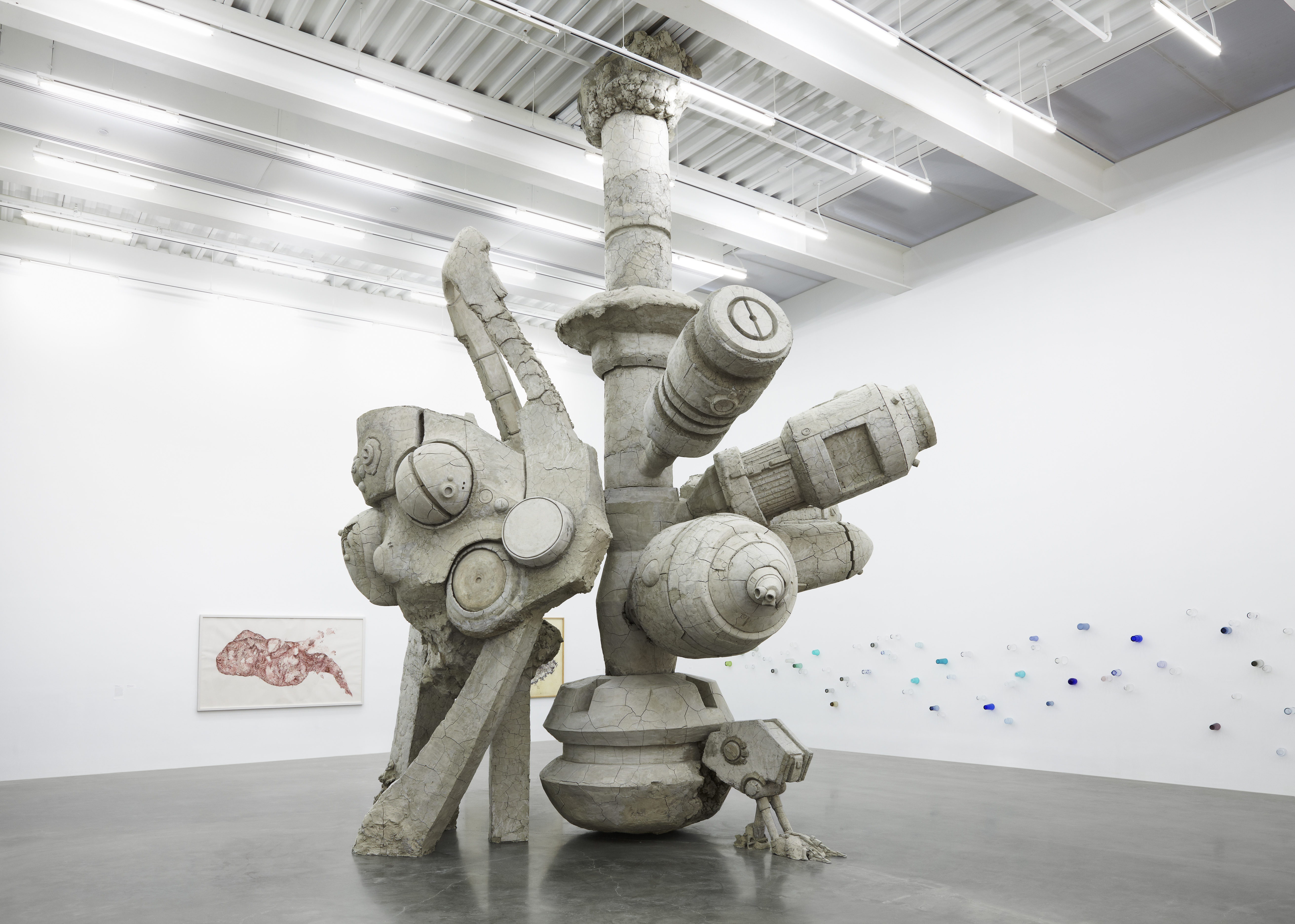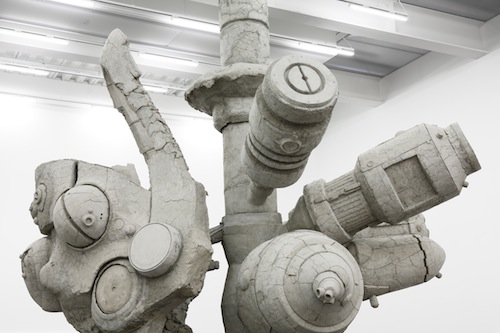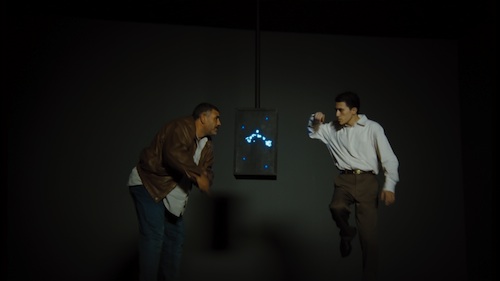
Adrián Villar Rojas. "A Person Loved Me," 2012. Clay, wood, metal, cement, Styrofoam, burlap, sand, paint. Courtesy the artist and kurimanzutto, Mexico City. Photo: Benoit Pailley.
The New Museum’s Triennial exhibition The Ungovernables seeks, as its title implies, to capture the restless urgency and strategies of resistance of artists born after the revolutionary impulses and upheavals of the 1960s and 1970s. Consisting of thirty-four artists or collaborative groups, the majority of which hail from outside the United States and Western Europe, The Ungovernables is a rewarding exhibition filled with moments of levity, gravity, and the occasional sign of a generation’s subversive restlessness. And while there is no prevailing aesthetic in The Ungovernables and the show has some uneven moments—as often happens with most group exhibitions of this scope and ambition—this sprawling exhibition also includes several standout works of art. Here are a few of my personal favorites.
Confronting visitors as they step off of the elevator on the top floor of the exhibition is Adrián Villar Rojas’s A Person Loved Me, an imposing sculpture of gargantuan proportion. Made of clay topping a metal, wood and cement armature, A Person Loved Me soars to the ceiling of the room, its clay surface molded and shaped to appear like machined metal, with vents, ducts, piping and valves jutting off in various directions from a central vertical axis. Rojas’s mysterious, imposing behemoth seems like some fragment of a futuristic weapons system (perhaps the Death Star, or the ship from Space Battleship Yamato), or an artifact from some lost civilization that time has long since rendered inoperative.

Adrián Villar Rojas. "A Person Loved Me," 2012 (partial installation view). Clay, wood, metal, cement, Styrofoam, burlap, sand, paint. Courtesy the artist and kurimanzutto, Mexico City. Photo: Benoit Pailley.
Rojas crafted his clay figure on site in the weeks before the exhibition’s opening, yet the work—its surface of unfired clay already riddled with cracks—seems weathered by time measured in centuries, not days. A Person Loved Me brims with the possibility of promise and peril and the suggestion of utility, yet it stands mute and inert, its crumbling surface adding an almost forlorn air. The power of Rojas’s work stems from its ability to simultaneously evoke the prospect of an unrecoverable past and some unknowable future, mingling a sense of the grandeur of permanent forms with the poignancy of decay.
Not surprisingly in this current age of global flux, unprecedented revolutionary upheavals, and the attendant anxieties fostered by their uncertain outcomes, the theme of impermanence underscoring Rojas’s work can be seen as something of a leitmotif that reappears throughout The Ungovernables. Of course with a title like The Ungovernables, restlessness and disobedience are also thematic undercurrents that run through much of the exhibition. To my mind, the most enjoyable and incisive work engaging with these ideas is Pilvi Takala’s mixed-media installation The Trainee, 2008.

Pilvi Takala. "The Trainee / Working at Deloitte for a Month," 2008. PowerPoint presentation, color; 2:00 minutes (loop). Courtesy the artist and Galerie Diana Stigter, Amsterdam
The Trainee is a project that documents Takala’s month working as a trainee in the marketing department of Deloitte, a global financial advisory and risk management company. In the course of her month-long tenure at Deloitte, Takala, a Finnish-born artist based in Amsterdam, exhibits increasingly abnormal behavior that defies social and corporate norms and befuddles her co-workers, who are completely unaware that their department’s new trainee is in fact an artist, and that her activities—and their reactions—are being secretly recorded. The accompanying videos and PowerPoint slideshow document Takala’s progressively aberrant activities, which include sitting at her workspace in plain view of everyone in the office staring straight ahead for hours at a time, spending a day in the tax library conspicuously doing no work, and riding up and down in the building’s elevator for an entire work day as perplexed colleagues come and go.
Takala’s installation in The Ungovernables includes the company’s welcome letter, the key card provided to new trainees, a workstation and a computer. We are even made privy to voicemails and emails from her co-workers voicing concerns to each other and their bosses about Takala’s unusual workplace activities and behavior. Collectively, The Trainee is a fascinating exposition of the deeply ingrained normative behavior that defines social and corporate settings. But it is also more than that.
In his book The Practice of Everyday Life, French theorist Michel de Certeau considers the tactics everyday workers use to individualize mass culture and surreptitiously undermine the disciplining and controlling forces of institutional power. Although written in the early 1980s, it is easily relatable to such contemporary activities as checking Facebook while at work, extending a ten-minute task from your boss into fifteen or twenty, and other ways by which people carve out personal spaces within institutional systems. De Certeau viewed these activities as tactical resistances that reclaimed time and autonomy from the controlling structures and panoptical gaze of corporate power. Takala’s interventions into the cadenced rituals and prescribed behaviors of social and corporate existence at Deloitte take to extremes de Certeau’s notion of subverting institutional systems, encapsulating the Ungovernables themes of resistance, disobedience and the urgency to re-appropriate and re-assert a sense of individuality in the face of an increasingly corporatized world.
In the New Museum’s last Triennial exhibition in 2009, which put forward a more somber and cynical expression of generational angst and dislocation than this current exhibition, the most memorable work for me was Cyprien Gaillard’s video Desniansky Raion. Gaillard’s Desniansky Raion offered a stunning and melancholy rumination on the failures and consequences of Modernism’s utopian ideals, setting video footage of gang violence in a Russian housing project to the hypnotic electronic beats of a song by the legendary French DJ Koudlam. Three years later, the award for most unforgettable Triennial work goes without question to Hassan Khan’s Jewel (2010).

Hassan Khan. "Jewel," 2010. 35mm film transferred to Blu-ray, color, sound, paint, speakers, light fixture; 6:30 minutes (loop). Courtesy the artist and Galerie Chantal Crousel, Paris.
Jewel consists of a 35mm film that Kahn, a London-born artist now living and working in Cairo, Egypt, has transferred to HD video and projected onto a large screen set in a dark room. The video shows two Egyptian men, one dressed in corporate attire and the other in more working-class clothing, performing what can only be described as an awkward, intense and utterly mesmerizing dance-off set to the throbbing beats of a Shaabi song composed by Khan himself. Shaabi is a controversial but popular fusion of traditional Egyptian music and instruments with electronic sounds and beats. Dancing in decidedly distinctive styles to the thunderous pulse of the bass-heavy music, the two men in Kahn’s video stand as signifiers of social, class and generational difference through their movements, grooming, clothing and age. But like the popular Cairene music’s own contemporary fusion of musical styles, the dance, based on scenes of male interaction witnessed by Kahn on the streets of Cairo, also becomes emblematic of the vernacular expression and ever-evolving appropriation of broader and social and historical forms. Jewel’s two writhing bodies become signs of the complex conditions of identity construction—sites where the forces of class, power and history intersect. It is not to be missed.
The Ungovernables: 2012 New Museum Triennial is on view at the New Museum until April 22, 2012.



